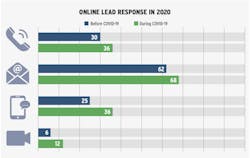How Good Is Your Online Lead Follow-Up—Even in a Crisis?
Until March 2020, the new-home market was on fire. “Spring” selling season started way back in December 2019, and many builders were seeing record numbers of leads and sales. Then a pandemic hit.
Since 2012, our company, Do You Convert, has conducted an annual survey of home builders to learn and show how they respond to online leads. We’re interested in how quickly and frequently builders follow up, which methods they use (or not) to capture leads and convert them to appointments, how results change year over year, and what conditions drive change.
This year our survey was especially poignant, given the radical market changes caused by COVID-19 health restrictions nationwide in March, April, and May.
RELATED
- New Benchmarks for Measuring Online Sales
- Welcome to the Sales Environment of the Future
- Need More Leads? Think Again
Home Builder Lead Followup Survey: How We Do It
In partnership with Clear Evaluations, a third-party company offering customer experience management and mystery-shopping solutions, we secret shopped a random sampling of 100 of the largest home builders by annual closings.
The 2020 survey comprised two separate secret shops. The first was conducted in early March of this year, before COVID-19 was declared a global pandemic.
Results from that effort reflect response rates and methods before any state or local stay-at-home mandates were enacted. Throughout this article, we refer to this period as “Before COVID-19.”
We initiated a second shop in early April to gather information about how home builders were responding to online leads during the pandemic. We hypothesized that during a time of reduced walk-in traffic and heightened online interest, builders’ follow-up response rates would dramatically increase. We refer to this period as “During COVID-19.”
For each builder secret shopped, we identified a specific community on their website and either filled out the interest form or submitted an email requesting information using a shopper’s name, mailing address, phone number, timeline for move, and explicit permission to use text messaging to communicate.
Online Lead Followup Survey Results: Before COVID-19
Our initial request (online lead) expressed: “We are looking at the homes you have ready in the next few months. Is everything under construction listed on your site? Also, this is my cell, so feel free to text me, too.” Then, we tracked the follow-up activities of those 100 builders for 45 days.
For leads received Before COVID-19, 70% of builders did not call a person who filled out an online inquiry for a specific community and 38% of builders did not return an online lead’s email inquiry.
In addition, 75% of builders did not text an online lead (even when invited to do so) and 94% of builders did not send a video email.
Compared with previous annual survey results, there’s not much difference in how builders follow up. Traditionally, we know that follow-up suffers most when market conditions improve, as reflected in the chart at left.
It’s no secret that the speed of a response to an online lead is a primary conversion factor. Ideally, during business hours, it should go out no more than 5 minutes after it’s received. But in reality, builders are responding with their first emails, call responses, and texts within 2.3, 1.5, and 2.9 days, respectively, not minutes.
Like speed, follow-up frequency is critical to success. It takes a minimum of five touch points for an online lead to respond. Of the builders that did respond, only a third followed up six or more times.
In other words, to be in the top 5% of U.S. builders that follow up with their leads, all that’s required is to send more than two emails, make more than one phone call, and send a single text. That’s a pretty low bar.
Online Lead Followup Survey Results: After COVID-19
For the During COVID-19 secret shop, we surveyed a different random sampling, this time of 25 of the largest home builders nationwide. We used the same methodology as the first shop and tracked follow-up activity for 30 days.
We thought COVID-19 would change the game. Our hypothesis was that because more consumers would be reaching out digitally and leads would be scarce, there would be a drastic improvement in the amount, speed, and frequency of home builder follow-ups to those online leads.
But in fact, we saw only a slight improvement in those metrics—in our opinion a significant missed opportunity for builders as web traffic and lead volume had actually increased year over year during this period*. [*From April 5 to May 5, 2020, website traffic for 50 U.S. builders was up 40.5% year over year, according to proprietary data from Do You Convert.]
Instead, our research found that 64% of builders did not call an online lead, 32% did not email, 64% did not text, and 88% did not send a video email (see chart, above). Again, a missed opportunity.
Key Takeaways From This Year's Home Builder Lead Followup Survey
Both the bad and good news is that builders are still not meeting customer demand in 2020, even in the midst of a pandemic. My main takeaways are:
1. The key to meeting demand is having the people and processes in place to respond fast and personally to every single lead. Our own research has shown that builders can generate 38% of total sales from a high-performing online sales program.
And while automation can certainly be a facilitator, alone it cannot solve the problem of lackluster follow-up. In fact, it’s best to conduct an automation audit to make sure leads aren’t being dumped into an unmonitored inbox or some other black hole.
2. Adjust when the market calls for it, don’t wait. The builders that performed best during COVID-19 aren’t those that scrambled to learn new technologies or put new programs in place; they’d already been testing and implementing new systems and processes to stay ahead of customer demand—and thrived as a result.
The double-edged sword here is that we remain in the midst of the coronavirus pandemic, but there is still an opportunity to get your house in order and catch up. In fact, the market cycle adjustment will still happen, it’s just a question of when. Make sure you’re prepared when the market slows (again) and all you have to fill your pipeline are online leads and digital interactions.
3. Many builders have a broken online sales system. The 2020 survey demonstrated that, for most builders, their online sales system is broken. All of the builders we shopped have enough money to fix a problem. Many of them already had what they thought were effective online sales programs. At some point, the program failed and too many qualified leads slipped through the cracks. Double-check every step of your process. Audit and adjust to make sure 100% of your leads are followed up with 100% of the time.
Benchmark and Build Capacity
We publish the results of our annual survey and share them industrywide so builders can identify areas for improvement. To download the full report from Do You Convert and watch the accompanying webinar, visit now.doyouconvert.com/2020-survey.
Remember, more leads isn’t the answer if the leads you already get are poorly managed. Before you sign up for another AI-powered system or spend another marketing dime, be sure you have the ability to follow up immediately and personally with every online lead and to continue that follow-up for 30 to 45 days with regular, relevant, and varied touch points.



